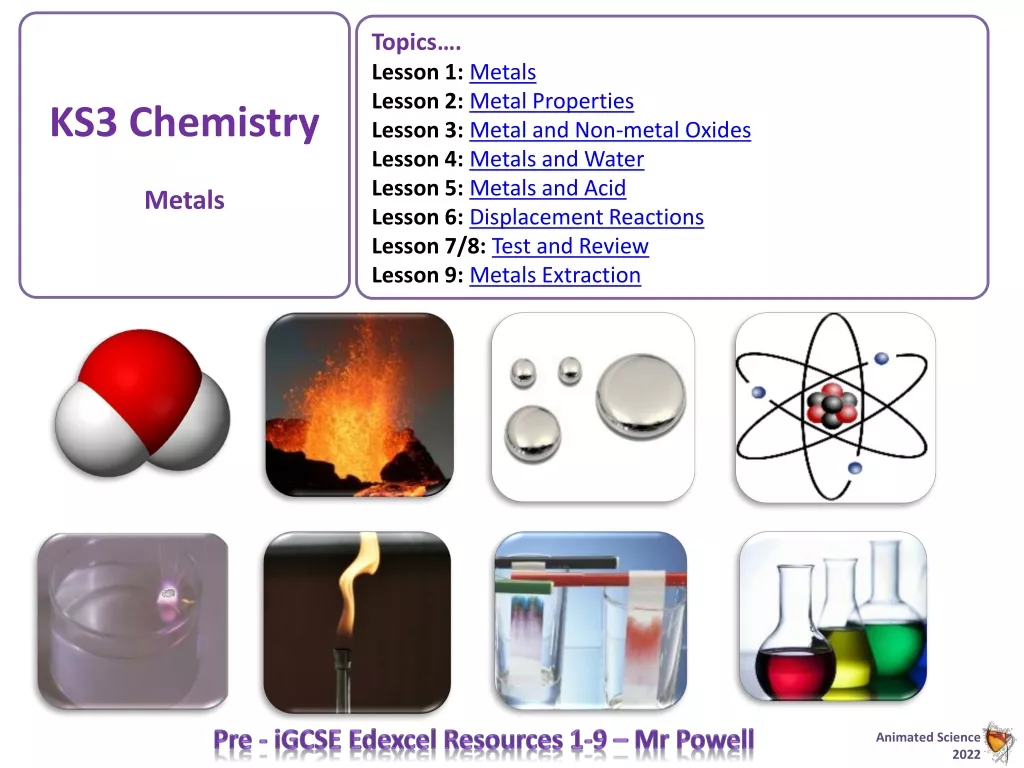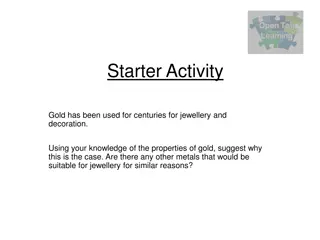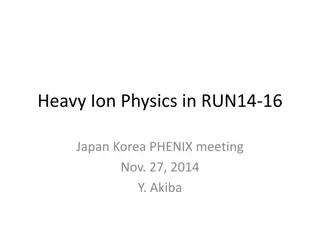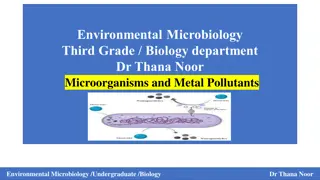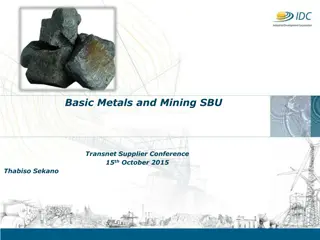Scrap Metal in Clayton That Offers Expert Collection & Transport Services
JJ Scrap Metals, located in Clayton, offers professional scrap metal collection and transportation services. With a team of experts boasting extensive industry knowledge, we assure you of maximising returns for your metals. Our goal is to provide efficient and reliable services, making it convenient
6 views • 4 slides
Metals: Properties, Reactions & Extraction in Chemistry
Explore the fascinating world of metals through lessons on their properties, reactions with water and acids, displacement reactions, extraction processes, and more. Delve into key terms, such as ions and reactivity series, while discovering how metals interact with various substances. Engage with re
2 views • 77 slides
Get Fair Scrap Metal Prices in Melbourne at JJ Scrap Metals
Scrap metal can negatively impact the environment if not managed properly, necessitating careful handling and recycling. \nAt JJ Scrap Metals, we have the expertise to recycle tons of used metals, including copper, aluminium, brass, lead, batteries, iron, wrecked cars, and vehicles. \nAs Melbourne's
2 views • 5 slides
Metals: Properties, Reactions, and Applications
Metals exhibit unique properties such as conductivity, metallic bonding, and reactivity with acids. They can be combined to form alloys with enhanced characteristics. This overview covers the properties, reactions, and utility of metals in various applications, providing insights into their behavior
2 views • 50 slides
Metals, Non-Metals, and Their Properties in the Periodic Table
Classification of elements into metals, non-metals, and metalloids based on their properties is essential. Metals are known for their conductivity and malleability, while non-metals have contrasting features like brittleness and poor conductivity. This detailed overview explores the physical propert
0 views • 31 slides
Interactive GCSE Chemistry Lesson on Metals and Non-Metals
Engage in a dynamic one-hour lecture focusing on metals and non-metals in GCSE Chemistry. Discover the properties of metals and non-metals, understand the metallic bond, and explore the periodic table. Participate in tasks of varying difficulty levels, discuss statements related to metals and non-me
1 views • 17 slides
The Conductivity of Metals in Electrical Circuits
This science fair project investigates how different metals affect the amount of current in an electrical circuit. It explores why metals are used to conduct electricity, which metal is the best conductor, and includes a hypothesis based on research findings. The experimental design involves setting
0 views • 15 slides
Metals, Nonmetals, and Metalloids in the Periodic Table
Explore the characteristics and physical properties of metals, nonmetals, and metalloids. Learn about the differences in appearance, conductive abilities, malleability, ductility, and other key features of these elements. Discover why metals are excellent conductors of heat and electricity, while no
0 views • 18 slides
Update on Informal Working Group Activities for AEBS in Heavy-Duty Vehicles
The Informal Working Group on AEBS for Heavy-Duty Vehicles has made significant progress in developing a draft regulatory proposal to revise UN Regulation No. 131. Key tasks include assessing accident situations, exploring a generic marker triggering AEBS, defining performance requirements, and more
8 views • 9 slides
Metals: Properties and Heat Treatment Processes
Metals can be categorized into ferrous and non-ferrous based on the presence of iron. Ferrous metals contain iron, while non-ferrous metals do not. Each type has distinct properties like toughness, tensile strength, elasticity, plasticity, ductility, malleability, and hardness. Heat treatment proces
0 views • 9 slides
Open Heavy-Flavour Production in pp Collisions at the LHC - Physics Seminar Overview
Physics seminar presentation by Francesco Prino on open heavy-flavour production as a function of multiplicity in pp collisions at the Large Hadron Collider (LHC). The talk covers the motivation behind studying heavy-flavour production mechanisms, data analysis techniques, results on the multiplicit
1 views • 65 slides
The Properties of Metals in Everyday Life
Explore the use of metals in society, focusing on gold's suitability for jewellery due to its unreactive nature, ability to be polished and shaped. Discover terms like lustre, malleable, ductile, and thermal conductivity, essential for understanding metal properties. Engage in activities to define t
0 views • 14 slides
Metal Extraction: Processes and Applications
Metals play a crucial role in various industries, but their extraction from ores is a complex process. Some metals occur naturally in an uncombined form, indicating their low reactivity. Through heat alone, unreactive metals like lead can be separated from their ores. This extraction process involve
2 views • 16 slides
Alloys and Corrosion in Metals
Alloys are mixtures of elements, with one being a metal, like bronze and brass. Gold jewelry is often alloyed with metals like silver and copper. Corrosion, the deterioration of materials through chemical reactions, can be prevented by using protective coatings. Different types of steels and aluminu
0 views • 4 slides
Types of Metals and Alloys Used in Construction
Various metals and alloys play crucial roles in construction, from bronze and copper to stainless steel and galvanized steel. Each material has unique properties and applications, such as bronze's malleability, copper's versatility, and stainless steel's resistance to oxidation. Understanding the ch
0 views • 73 slides
Heavy Metals and Their Impact on Organisms in the Environment
Heavy metals, such as zinc and copper, persist in the environment posing health risks to organisms. Industrial activities release toxic metals into water sources. Microorganisms can interact with heavy metal ions, altering their toxicity and resistance. Essential heavy metals are needed in small amo
0 views • 24 slides
Exploring the Vital Role of Metals in Modern Medicine
An in-depth look at the diverse roles metals play in contemporary medicine, from bio-essential functions to the development of metal-based drugs. Discover how metals like iron, lithium, and auranofin are utilized for medicinal purposes, alongside their applications in non-invasive radiopharmaceutica
0 views • 155 slides
Quarkonium in Medium and Transport in Heavy-Ion Collisions
Discussing the properties and behavior of quarkonium in medium and its transport in heavy-ion collisions. Topics include heavy-quark potential, confinement, quarkonia at finite temperature, quarkonium transport, and quarkonia in heavy-ion collisions. Insightful details about in-medium potential and
0 views • 30 slides
Heavy Metal Toxicity: Lead and Mercury Poisoning
Lead and mercury poisoning are serious health concerns caused by exposure to these toxic heavy metals. Lead, commonly found in products like batteries and paints, can lead to developmental delays, abdominal pain, and more. On the other hand, mercury, present in various forms, can cause symptoms such
0 views • 6 slides
Heavy Ion Physics at RHIC: RUN14-16 Overview
Exploring heavy ion physics at RHIC through the RUN14-16 campaigns, focusing on measuring heavy quarks like charm and bottom, the experimental setups, beam energies, and the significance of probing Quark Gluon Plasma using heavy quarks. Detailed information about the runs, detectors used, and the ma
0 views • 19 slides
Data Plane Heavy Hitter Detection and Switches: A Comprehensive Overview
In this comprehensive guide, explore the concepts of heavy-hitter detection entirely in the data plane, the significance of detecting heavy hitters, emerging programmable switches, existing techniques, and constraints faced in processing heavy flows. Discover the motivation behind the Space-Saving A
0 views • 33 slides
Biosorption of Nickel and Copper by Camel Foot Pod for Heavy Metal Removal in Wastewater
Sustainable development efforts emphasize environmental protection, including water pollution control. This study explores the biosorption of nickel and copper using camel foot pods to remove heavy metals from simulated wastewaters. The introduction highlights the significance of addressing high hea
0 views • 29 slides
Metal Smelting and Electrorefining Techniques Explained
Smelting is a process involving the dissolution of pure alumina in a molten mixture of cryolite and fluorspar to extract metals like aluminum. Electrolysis is used to separate the metals where oxygen is liberated at the anode and the metal is deposited at the cathode. This process is illustrated wit
0 views • 29 slides
Challenges in Ensuring Critical Mineral Supply for Japan's Sustainable Industrial Activities
Japan faces challenges in securing critical minerals for sustainable industrial activities due to market failures in rare metals trade, lack of information symmetry in supply chains, and the small market size of rare metals. The Government of Japan implements policy measures such as overseas resourc
0 views • 15 slides
Challenges and Impacts of Active Metals in Electrochemical Technologies
Safety concerns arise from the reactivity of active metals like lithium, leading to fire and explosion risks. Economic challenges include high costs and limited availability of these metals. Environmental aspects highlight pollution risks from improper disposal. Images and descriptions illustrate th
0 views • 7 slides
Characteristics and Families of the Periodic Table: A Comprehensive Overview
Explore the characteristics of the periodic table including the alkali metals, alkaline earth metals, transition metals, lanthanides, actinides, and more. Learn about the properties, valence electrons, and uses of different groups, such as the boron group, carbon group, nitrogen group, oxygen group,
0 views • 8 slides
Metallic Bonding and Its Properties
Metallic bonding involves the delocalization of electrons among metal atoms, creating a unique structure known as the electron sea. This structure allows for properties such as high melting points, conductivity of heat and electricity, malleability, and ductility. Metals are able to conduct heat and
0 views • 12 slides
Physical and Chemical Properties of Metals and Non-metals
Metals exhibit physical properties like lustrous appearance, ductility, malleability, and sound production. They are also good conductors of heat and electricity. Non-metals, on the other hand, are brittle, non-sonorous, and poor conductors of heat and electricity. The chemical properties include re
0 views • 13 slides
Reactivity of Metals and Non-Metals: A Comprehensive Overview
Metals like potassium and sodium react vigorously with water, while non-metals like phosphorus are highly reactive and stored in water. Metals react with acids to form hydrogen gas, while non-metals generally do not react with acids. Reactivity series explains displacement reactions where more react
0 views • 11 slides
Lightweight and Corrosion-Resistant Metals: Aluminium and Titanium
Two metals, Aluminium and Titanium, known for their low density and resistance to corrosion, are essential in various industries. Their extraction processes are expensive due to energy requirements and multiple stages involved. Aluminium is extracted from bauxite using the Bayer process, while Titan
0 views • 9 slides
The Role of Microorganisms in Mitigating Heavy Metal Pollution
Metal pollution poses health and ecological risks globally, with heavy metals like mercury and lead causing various harmful conditions. Microorganisms play a crucial role in altering the bioavailability and toxicity of metals. By converting elemental mercury to methylmercury and affecting the valenc
0 views • 9 slides
Neutron Star Mergers and Ultra Heavy Element Cosmic Rays: Exploring Their Connection
Delve into the intriguing link between neutron star mergers and the synthesis of ultra heavy element cosmic rays. The rapid neutron capture process, known as r-process, plays a crucial role in creating elements heavier than iron through events like neutron star mergers and core-collapse supernovae.
0 views • 19 slides
Optimizing LOD in Time-Resolved VUV LIBS for Light Elements in Metals
Laser-Induced Breakdown Spectroscopy (LIBS) is a powerful analytical method used to detect elemental composition in various states. This research focuses on optimizing the Limit of Detection (LOD) for Time-Resolved Vacuum Ultraviolet (VUV) LIBS, particularly for light elements in metals. The study a
0 views • 35 slides
The Classification of Elements in the Periodic Table
In 1869, Mendeleev and Lothar Meyer published classification schemes for elements, leading to the development of the Periodic Table. This table organizes elements based on properties and reactivities, with each element having a unique atomic number. There are 92 naturally occurring and 13 man-made e
0 views • 31 slides
Alkali Metals: Group 1 Elements
Alkali metals, found in Group 1 of the Periodic Table, include elements like lithium, sodium, and potassium. These metals are highly reactive, with properties that change as you move down the group. They have low densities and melting points, and their reactivity increases from top to bottom. Learn
0 views • 12 slides
Chemistry Fundamentals: Elements, Mixtures, Metals, and Changes
Explore fundamental concepts in chemistry including elements found on the periodic table, types of mixtures, characteristics of metals and non-metals, periodic table groups, chemical vs. physical properties, and changes in matter. Learn about the properties and behaviors of elements, compounds, and
0 views • 12 slides
Heavy Metal Toxicity: Impacts on Aquatic Life and Human Health
Heavy metal toxicity poses a significant threat to both aquatic ecosystems and human health, with various heavy metals accumulating in the environment and food chain. This overview highlights the adverse effects of heavy metals like copper, nickel, zinc, cobalt, and cadmium on physiological processe
0 views • 39 slides
Brahmi Vati Gold The Metals and Minerals That Make It Unique
Renowned as an Ayurvedic brain tonic, Brahmi Vati Gold stands out due to its unique blend of carefully chosen herbs, minerals and precious metals. Explore the benefits of the metals and minerals that make it exceptional.\nSourceLink [\/\/thepunarvasu
0 views • 7 slides
Understanding Erosion Corrosion in Materials Engineering
Erosion corrosion is the deterioration of metals and alloys due to relative movement between the surface and corrosive fluids. It is characterized by grooves and surface patterns with directionality. This type of corrosion can affect a wide range of equipment exposed to fluids, such as piping system
0 views • 12 slides
Basic Metals and Mining SBU
The IDC Metals Value Chain aims to develop a competitive local metal products industry and strong export markets. The Mining and Basic Metals unit focuses on deal making and project management, with expertise in project initiation and development, partnering with investors, and funding opportunities
0 views • 11 slides

